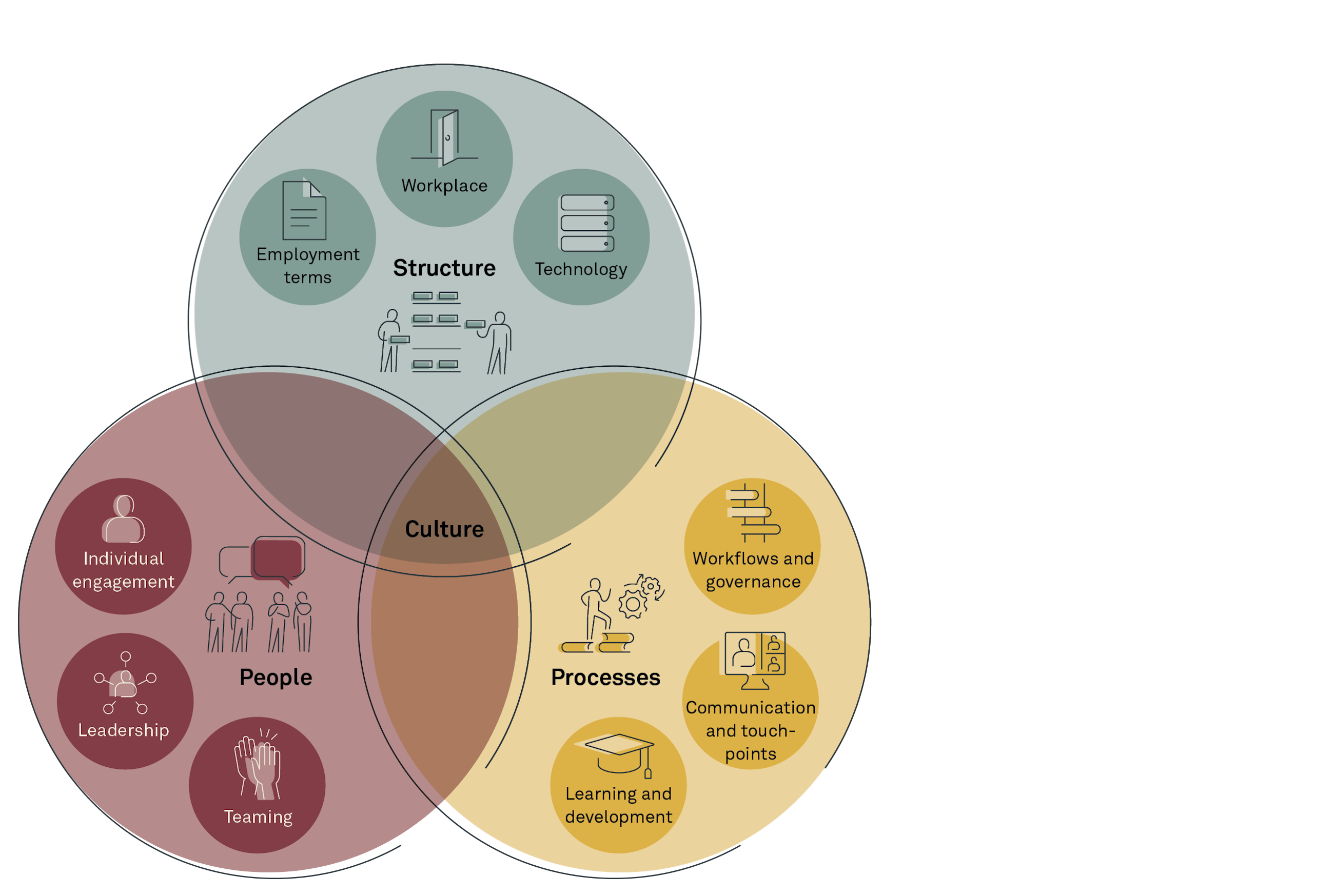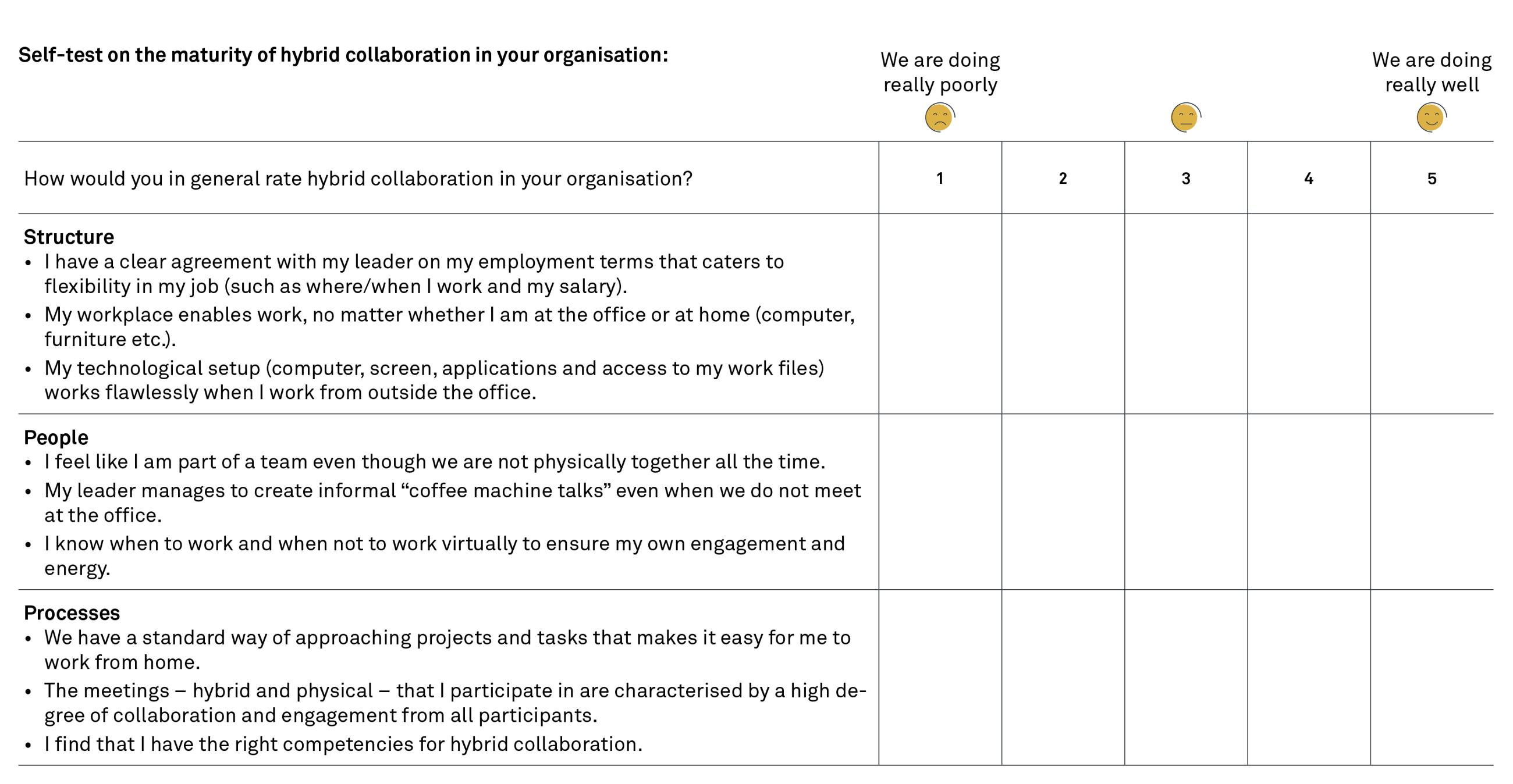The key to building future-fit organisations
3 March 2022
Hybrid collaboration is key to the future way of working. We believe that if hybrid collaboration is done right, it has huge unexplored benefits and opportunities for business leaders who want to build organisations that are fit for humans and fit for the future.
We want to enable organisations to fully utilise the opportunities of hybrid collaboration. Therefore, we have built a framework to provide a holistic approach.
Working successfully with hybrid collaboration, we have identified three dimensions that should be addressed: people, processes and structure. This includes some basic prerequisites for good hybrid collaboration; however, as people are different, so are organisations, and the right way for one company might not be the same for others.
Overall, the framework can be used for looking at the hybrid collaboration culture at your company – in its current state and in the one you are aspiring for .
Our definition of hybrid collaboration
“Some people work mostly in person at the same location, whereas other people in the same company are remote. Or most people working some days in the central office and some days from home or another remote location. In essence, hybrid collaboration is collaborating across physical and virtual boundaries.”
Hybrid collaboration – the new normal?
We see that hybrid collaboration is growing exponentially in organisations, as more and more people work remotely while others are back at the office.
If you look more closely, you will see that hybrid collaboration is more than the location you work from. It affects an array of elements in the way we run our business, ranging from the formal regulations of a home office, the lack of coffee machine talks when we do not meet at the office, work processes and competencies that foster collaboration on virtual platforms and leadership at a distance.
The concept
...of hybrid collaboration tends to have many names such as “future way of working”, “hybrid work”, “hybrid collaboration”, “new ways of working”; and regardless of which name tag you put on it, hybrid collaboration is essentially collaborating across physi-cal and virtual boundaries.
We believe that hybrid collaboration is here to stay or even increase due to several factors:
- Increased globalisation of the companies we work at or the supply chains and ecosystems which the business is part of as well as our increased focus on a more sustainable world drive us towards being more virtual.
- Increased efficiency and reduced costs due to less time and money spent on travelling abroad.
- The market for technologies that support a more sustainable, hybrid work life is increasing at tremendous speed.
- In the war for talent, hybrid collaboration will expand the possibilities of getting the best people on board with less focus on where they live physically.
Several recent studies support the tendency towards a more hybrid work life. HBR finds that 70-80% of organisations are already considering themselves hybrid . In a recent survey from Microsoft, involving more than 30,000 people from 31 different countries, 70% of workers want the flexible, remote work options to continue. But the new hybrid world also demands something from the organisation, as 65% are craving more in-person time with their teams . We must bridge this dilemma with the way we create our organisations and our culture around hybrid collaboration.
In this article, we will unfold our framework to improve hybrid collaboration through a focus on the three overall dimensions of the framework: people, processes and structure.
Before you continue reading, take a moment to reflect on:
How would you in general rate hybrid collaboration in your organisation?
What are the main challenges of hybrid collaboration?
- “How do we stay connected with each other when we do not see each other randomly by the coffee machine?”
- “How do we as leaders lead from a distance?”
- “How do we make sure to keep ourselves and our colleagues engaged and motivated for work?”
- “How do we know if people are feeling okay?”
- “How do we design our workplace to cater to this new way of collaborating?”
- “What should the formal agreements be in relation to working from home vs from the office?”
- “When and where do we expect people to work?”
- “How do we make sure that we have the right processes and technological setup for virtual collaboration?”
Structures enabling hybrid work
The structure dimension contains the infrastructural elements needed to make hybrid work possible and a success. This has to do with questions like: “Do we have the necessary technical setup for hybrid collaboration?”, “Does the workspace cater to hybrid collaboration?” and “Do we provide employment terms that deal with hybrid work?”
The elements are employment terms, the workplace and technology.
Employment terms cover the legal perspectives of making hybrid collaboration possible. Which terms need to be changed in the employment contracts? Which renumeration aspect needs to be revised (fees, bonus terms, driving costs etc.)? Is there a need for changing the insurance policies of the individual and of the company to cater to working more from home? And then comes policies on the home office environment which also varies a lot depending on the agreement between the employee and the employer. How many days is the individual working from home vs from the office, are the working hours from home on specific days or flexible and fluid?
All these questions and considerations determine to which degree the employer has a responsibility for providing the right home office equipment such as ergonomic chairs, adjustable desks and so on. The questions might have different answers in different countries, which means that each company will have to go through it in detail and might also need to communicate and handle big differences in the workforce of the same department in a global organisation.
The physical workplace covers the space where people work at the office but also remote offices, as both can support hybrid collaboration. Imagine employees working some days at the office, going in and out of physical and virtual meetings. Meeting rooms are still as they were back when we primarily met face to face. We do not want to take up a whole meeting room for our 1:1 virtual touchpoints with colleagues from other geographical sites, but the canteen or open office spaces do not fit the purpose of this type of meeting either because of poor sound quality or because we disturb each other. So what do we do?
The physical workplace needs to be (re)designed to support the new ways of working based on an analysis of the needs of the organisation. This could be “phone booths” for virtual meetings, fewer but better workstations, smaller rooms and different areas supporting the new ways of working.
Technology is key to supporting hybrid collaboration. Most organisations have solid technology supporting the virtual ways of meeting but need to improve the technical setup to also meet the need for hybrid collaboration.
Hybrid collaboration adds to the technological complexity which must be in place to fully leverage the potential of this way of working. The technical equipment, e.g. computers, cameras, microphone and sound setup, must be well functioning at the office as well as from remote workstations. Bad sound quality is not just disturbing in the long run. Enabling Wi-Fi access as well as remote access to your desk and files requires a proper bandwidth, VPN and strong security solutions. Software to support synchronous and asynchronous work must also be in place to support efficient hybrid work. And finally comes the question of whether the individual must ensure a minimum standard for their home office to allow for working from home without slowing down the collaboration with others.
Depending on the setup, this might also be a question that we deal with under the employment terms.
Processes that cater to hybrid collaboration
As we add the virtual dimension to our work life, we add opportunities and complexities in the way we work and govern our organisations. This might call for adapted or new workflows and governance, awareness of our communication and touchpoints and an eye for learning and development. Where should we adapt our workflows or even governance to make hybrid work possible and even more rewarding? How do we ensure a sufficient level of communication and quality? What capabilities are needed to change behaviour and for everyone in the organisation to be able to adapt to these new ways of working?
Workflows and governance
We need to adapt our workflow in the organisation to the new ways of working. The new opportunities and requirements for hybrid collaboration might be relevant to include in a project model. It could be looking into questions such as:
- Do we need to revise how we make decisions?
- Is the way we work with projects and our project model in line with this way of working?
- Are the major workflows in our administrative part of the business adjusted to hybrid work?
- How do we settle the question of worktime and workplace?
Communication and touchpoints
Physical and technological distance challenges many of our traditional ways of communicating and having touchpoints. Therefore, focusing on communication and touchpoints is a particularly important factor in hybrid collaboration.
Touchpoints
Touchpoints, meetings and workshops are key elements in our ongoing communication. To perform with high engagement and impact, we need to be able to host engaging and productive meetings in a virtual or hybrid format where we create engaging and meaningful interactions. Many organisations have experienced challenges with keeping people engaged in virtual sessions, and it seems even more difficult if you need a high degree of creativity in your session. A new key question when organising meetings and workshops could be: Does this require physical presence, or will it work if we go virtual?
Communication
Company-wide communication must aim at sharing important information across the entire organisation to maintain engagement, a shared direction and the sense of belonging to something bigger. This could also be to highlight elements of governance to set a direction. When the workplace gets dispatched, communication becomes an even stronger way of nurturing the culture we want to live.
Learning and development
Hybrid collaboration requires some basic virtual skills for it to work at all – all employees need to know the basic functions in Teams, Zoom or your preferred communication program to be able to engage. On top of this, Teams has many more features to use, and several virtual collaboration tools are developed that can support various kinds of work in a virtual world with visualisation, planning and documentation, e.g. Miro, SessionLab etc.
In short, the better the employees know how to use collaboration tools, the smoother it can run – but it might take some training to get everybody there.
Another element is how an organisation ensures continuous learning and development in general in a hybrid setup where we might get less inspiration or help growing from the colleagues sitting next to us. Hence, knowledge sharing and onboarding will be important areas to have a plan for in this dimension.
People – making hybrid collaboration more human
Hybrid collaboration involves large changes to the way many people work – and work together.
Working virtually and out of the home office can be flexible and is attractive to many. At the same time, remote work involves a range of barriers to collaboration, ranging from physical, technological and emotional distance that we need to deal with. Finally, studies show that we miss face-to-face relations with colleagues and leaders, and many employees cannot wait to get back to the office (at least some days a week).
As with all big transformations, we must pay careful attention to the people who are involved in the change needed to do hybrid collaboration, both in the transition phase but also in the long run.
The people dimension highlights the individual’s engagement, how he or she can stay connected and engaged, the team as a place of belonging with a high degree of trust and the leadership required to lead at a distance.
Individual engagement (at work)
Hybrid work has been a godsend for some employees for whom work has become more flexible and easier to combine with family logistics, or it has created space for introvert preferences and deep work. Remote collaboration and the many hours alone at the home office can be mentally exhausting, and the lack of face-to-face interactions with colleagues might cause a feeling of being less engaged at work.
Therefore, it is extremely important to help the individual design their work in a way that fosters energy and engagement by having a focus on equipping individuals to manage their individual engagement.
Leadership
Leadership at a distance is an integrated part of hybrid collaboration, as we are not together at the office every day. Mastering this discipline is key to success.
Successful leadership at a distance has to do with staying connected to employees, creating motivation, keeping an overview of performance and setting the direction of a team, and it requires something different than if we meet daily.
Teaming
For most people, it is important to have a sense of belonging to someone, a workplace you are proud of, a team that supports you or a group of colleagues that you share a professional passion with. This is why teaming is the third element of the people dimension.
A strong team is able to perform together and maintain a high level of engagement. They typically have a high degree of trust, a clear purpose and goal, commitment and hold each other accountable. Some things can be handled in virtual or hybrid meetings or through an informal Slack, Yammer or WhatsApp channel. At other times, we need to meet; and to succeed, it is important that we know when to do what.
Finally, an area of awareness is the informal touchpoints that, to some extent, have disappeared. They no longer happen by accident, as the shared coffee machine as a natural trigger of random meetings is gone. These kinds of random meetings help us stay connected, share relevant knowledge and be aware of each other’s well-being, and we know that a lot of people miss them.
This calls for alternative ways to connect informally. We have seen many examples, from informal weekly team check-ins, a note with names to call while driving and Excel sheets that randomly choose a name or a walk and talk with a colleague on the phone – all ideas for how to stay connected and energised.
How are you doing on hybrid collaboration?
Along with our framework covering people, processes and structure, we have also developed an assessment tool that you can find a simplified version of here.
Be aware that the areas are interconnected. If we change a workflow, it requires something from the technology and the leadership responsible; therefore, fixing one thing in one area affects other areas.
Test the assessment tool to find out where you currently are – and where it would make sense to start or do more.
Outro
We hope that this article has provided you with a better understanding of which dimensions you and your organisation should focus on if you want to start fully utilising the benefits of hybrid collaboration.
You may have used the assessment tool to take a first look at where you are already supporting hybrid work and where you should improve to support it even further. Maybe you even got inspired to change your team, department or organisation towards a more hybrid collaboration culture – more fit for humans and fit for the future.
If you are curious to know more about how we work with the different dimensions, or if you want to run a more thorough assessment in your organisation, please do not hesitate to reach out to us.
Read more
https://www.microsoft.com/en-us/worklab/work-trend-index/hybrid-work
Hybrid Work Is Here to Stay. Now What? (Back to Work, Better). (Podcast) Harvard Business Review (2021, June 29). HBR IdeaCast, episode 807.
https://hbr.org/podcast/2021/06/hybrid-work-is-here-to-stay-now-what
Lessons from One Law Firm’s Pre-Pandemic Shift to Hybrid Work. Sher, R. (2021, June 23). Lessons from One Law Firm’s Pre-Pandemic Shift to Hybrid Work. Harvard Business Review. https://hbr.org/2021/06/lessons-from-one-law-firms-pre-pandemic-shift-to-hybrid-work
Culture in the hybrid workplace. Hancock, B., Schaninger, B., and Weddle B. (2021, June 11). Culture in the hybrid workplace. McKinsey & Company. https://www.mckinsey.com/business-functions/people-and-organizational-performance/our-insights/culture-in-the-hybrid-workplace
3 Traits You Need to Thrive in a Hybrid Work Environment
Chamorro-Premuzic, T., & Akhtar, R. (2021, August 3). 3 Traits You Need to Thrive in a Hybrid Work Environment. Harvard Business Review. https://hbr.org/2021/08/3-traits-you-need-to-thrive-in-a-hybrid-work-environment
Bring the Outdoors into Your Hybrid Work Routine
Routledge, C. (2021, September 16). Bring the Outdoors into Your Hybrid Work Routine.
Harvard Business Review. https://hbr.org/2021/09/bring-the-outdoors-into-your-hybrid-work-routine







